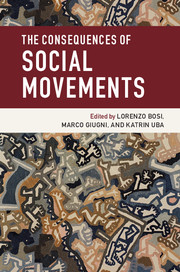Book contents
- Frontmatter
- Contents
- List of figures
- List of tables
- List of contributors
- Introduction
- Part I People
- 2 All is not lost: the 1984–85 British miners’ strike and mobilization after defeat
- 3 Personal effects from far-right activism
- 4 The biographical impact of participation in social movement activities: beyond highly committed New Left activism
- 5 Examining the intergenerational outcomes of social movements: the case of feminist activists and their children
- 6 Aggregate-level biographical outcomes for gay and lesbian movements
- Part II Policies
- Part III Institutions
- Conclusion
- Index
- References
4 - The biographical impact of participation in social movement activities: beyond highly committed New Left activism
from Part I - People
Published online by Cambridge University Press: 05 January 2016
- Frontmatter
- Contents
- List of figures
- List of tables
- List of contributors
- Introduction
- Part I People
- 2 All is not lost: the 1984–85 British miners’ strike and mobilization after defeat
- 3 Personal effects from far-right activism
- 4 The biographical impact of participation in social movement activities: beyond highly committed New Left activism
- 5 Examining the intergenerational outcomes of social movements: the case of feminist activists and their children
- 6 Aggregate-level biographical outcomes for gay and lesbian movements
- Part II Policies
- Part III Institutions
- Conclusion
- Index
- References
Summary
Introduction
Studying the outcomes of social movements is important if we want to elucidate the role of collective action in society. While most works have addressed aggregate-level political outcomes such as changes in laws or new policies, a relatively small but substantial body of literature deals with the personal and biographical consequences of social movements at the micro-level, that is, effects on the life-course of individuals who have participated in movement activities, due at least in part to involvement in those activities (see Giugni 2004 for a review). In general, these studies converge in suggesting that activism has a strong effect both on the political and personal lives of the subjects. Most of the existing studies, however, share a number of features that limit the scope of their findings. First, they focus on a specific kind of movement participants, namely movement activists, most often New Left activists, who are strongly committed to the cause. Yet, as suggested by McAdam (1999a), not more than between 2% and 4% of the American population took part in New Left activism of the 1960s. As a result, we cannot directly generalize from these findings to the biographical impact of participation in social movements by less strongly committed people who, in addition, might belong to other ideological areas, not necessarily to the New Left. Second, they use only a limited number of subjects and often do not analyze non-activists. The possibility of generalizing the findings is therefore very limited due to the small samples used and the lack of a control group of non-activists. Third, they look at a specific geographical and area and historical period, namely the United States (or often even more circumscribed geographical areas) in the late 1960s and early 1970s. As such, we do not know from these studies how movement participation may affect the lives of people more generally. Thus, overall, in spite of the crucial insights that these works provided, they have little to say about the effects of more “routine” forms of participation.
In this chapter we try to go beyond the traditional focus on highly committed New Left activism to investigate the impact of protest participation on political life-course patterns amongst the general population. Our main research question is the following: Does participation in social movement activities, such as participation in protest activities, have an enduring impact on the subsequent political life of individuals?
- Type
- Chapter
- Information
- The Consequences of Social Movements , pp. 85 - 105Publisher: Cambridge University PressPrint publication year: 2016
References
- 24
- Cited by



